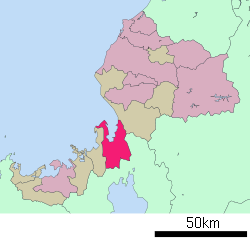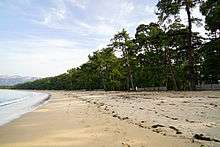Tsuruga, Fukui
| Tsuruga 敦賀市 | ||
|---|---|---|
| City | ||
| ||
 Location of Tsuruga in Fukui Prefecture | ||
 Tsuruga Location in Japan | ||
| Coordinates: 35°39′N 136°3′E / 35.650°N 136.050°ECoordinates: 35°39′N 136°3′E / 35.650°N 136.050°E | ||
| Country | Japan | |
| Region | Chūbu (Hokuriku) | |
| Prefecture | Fukui Prefecture | |
| Government | ||
| • Mayor | Takanobu Fuchikami | |
| Area | ||
| • Total | 250.74 km2 (96.81 sq mi) | |
| Population (October 1, 2005) | ||
| • Total | 68,401 | |
| • Density | 272.80/km2 (706.5/sq mi) | |
| Symbols | ||
| • Tree | Pine | |
| • Flower | Lespedeza | |
| • Bird | Black-headed gull | |
| Time zone | Japan Standard Time (UTC+9) | |
| City hall address |
2-1-1 Chūō-chō, Tsuruga-shi, Fukui-ken 914-8501 | |
| Website |
www | |
Tsuruga (敦賀市 Tsuruga-shi) is a city in Fukui Prefecture, Japan. It is the largest city in Japan's Wakasa region.
History
An Imperial decree in July 1899 established Tsuruga as an open port for trading with the United States and the United Kingdom.[1]
Bashō (1644-1694) wrote a celebrated haiku on the moonlight over Tsuruga bay.
Tsuruga was incorporated as a city on April 1, 1937.
Tsuruga is known for its two nuclear power facilities - the Monju demonstration nuclear plant and the Tsuruga Nuclear Power Plant.
Tsuruga was the only Japanese port opened to the Polish orphans in 1920, and to the Jewish refugees in 1940 thanks to Jan Zwartendijk, the Dutch Consul in Kaunas, who issued visa for Curaçao and Surinam, Mr. Chiune Sugihara, Vice-Consul for the Empire of Japan in Lithuania could issue transit visa for Japan. These historic events are detailed at the Port of Humanity Tsuruga Museum. Jan Zwartendijk is honored in Israel, Lithuania and The Netherlands. In Japan his work is rather unknown so far.
Geography
Situated on Wakasa Bay, Tsuruga lies some 50 km south of Fukui, 90 km northwest of Nagoya, 40 km northwest of Maibara, 115 km northeast of Osaka, 75 km northeast of Kyoto, and 65 km east of Maizuru.
Among cities on the Japan Sea coast, Tsuruga is the nearest city to the Pacific Ocean. The distance between Tsuruga and Nagoya is only 115 km. Tsuruga and Nagoya are historically close to Shiga Prefecture and Kyoto.
Climate
Tsuruga has a humid subtropical climate (Köppen climate classification Cfa) with hot summers and cool winters. Precipitation is plentiful throughout the year, and is particularly heavy in December and January.
| Climate data for Tsuruga, Fukui | |||||||||||||
|---|---|---|---|---|---|---|---|---|---|---|---|---|---|
| Month | Jan | Feb | Mar | Apr | May | Jun | Jul | Aug | Sep | Oct | Nov | Dec | Year |
| Average high °C (°F) | 6.9 (44.4) |
7.2 (45) |
10.8 (51.4) |
17.2 (63) |
21.9 (71.4) |
25.0 (77) |
29.3 (84.7) |
31.1 (88) |
26.7 (80.1) |
21.2 (70.2) |
15.9 (60.6) |
10.3 (50.5) |
18.63 (65.53) |
| Daily mean °C (°F) | 3.9 (39) |
4.0 (39.2) |
6.9 (44.4) |
12.9 (55.2) |
17.5 (63.5) |
21.3 (70.3) |
25.5 (77.9) |
27.0 (80.6) |
22.7 (72.9) |
16.8 (62.2) |
11.8 (53.2) |
6.9 (44.4) |
14.77 (58.57) |
| Average low °C (°F) | 1.0 (33.8) |
0.9 (33.6) |
3.0 (37.4) |
8.5 (47.3) |
13.2 (55.8) |
17.8 (64) |
22.3 (72.1) |
23.5 (74.3) |
19.2 (66.6) |
12.7 (54.9) |
7.7 (45.9) |
3.5 (38.3) |
11.11 (52) |
| Average precipitation mm (inches) | 312.0 (12.283) |
207.1 (8.154) |
167.9 (6.61) |
146.2 (5.756) |
146.8 (5.78) |
216.2 (8.512) |
220.2 (8.669) |
130.9 (5.154) |
220.6 (8.685) |
157.0 (6.181) |
190.4 (7.496) |
303.6 (11.953) |
2,418.9 (95.233) |
| Average snowfall cm (inches) | 118 (46.5) |
92 (36.2) |
19 (7.5) |
0 (0) |
0 (0) |
0 (0) |
0 (0) |
0 (0) |
0 (0) |
0 (0) |
1 (0.4) |
34 (13.4) |
264 (104) |
| Average relative humidity (%) | 75 | 73 | 69 | 68 | 69 | 75 | 77 | 74 | 76 | 73 | 72 | 73 | 72.8 |
| Mean monthly sunshine hours | 63.7 | 72.1 | 133.3 | 162.9 | 192.7 | 144.2 | 170.1 | 205.3 | 141.6 | 147.5 | 108.6 | 75.9 | 1,617.9 |
| Source: NOAA (1961-1990)[2] | |||||||||||||
Economy

Tsuruga has a very healthy mixed economy focused on providing services to the Wakasa region, and also features a container port, a bulk terminal, a coal-fired power plant, two textile mills, a large furniture factory, a playground equipment manufacturer, and a Panasonic (Matsushita) facility. Education and energy research also drive the economy.
Activities
Well-known Japanese DJ Chikashi Nishiwaki also founded his eclectic club, Tree, here. The club has been host to many national and international celebrity guests such as Jazztronik, Gilles Peterson, Toshio Matsuura from UFO, DJs Ravi, Julien Love and Two Dee, and Soil and Pimp Sessions. He has also mixed music with Tyronne Noonan, former frontman of George.
About twenty or so bronze statues – each perhaps four or five feet tall – of characters and scenes from the popular 1970s anime Uchū Senkan Yamato (Space Battleship Yamato or, in the United States, Star Blazers) and Galaxy Express 999 were erected in the city's downtown area in 1999. Though the creator of these shows, Leiji Matsumoto, was born elsewhere, an exhibit of his artwork was held in the city in 1999 as part of the city's 100th anniversary celebration, accompanied by the erection of the statues.
Transportation

- Railway
- central station : Tsuruga Station
- Hokuriku Main Line
- Obama Line
- Kosei Line
- Road
- Port
Sister cities

See also
| Wikimedia Commons has media related to Tsuruga, Fukui. |
References
- ↑ US Department of State. (1906). A digest of international law as embodied in diplomatic discussions, treaties and other international agreements (John Bassett Moore, ed.), Vol. 5, p. 759.
- ↑ "Tsuruga Climate Normals 1961-1990". National Oceanic and Atmospheric Administration. Retrieved December 31, 2012.
.
External links
- (Japanese) Official website
- (Japanese) Galaxy Express 999 and Space Battleship Yamato statues in Tsuruga
